It has been a while since the last time I wrote an update about Tianwen-1’s attitude. In that post I showed that Tianwen-1 had changed to a sun angle of 0 degrees with respect to the spacecraft’s X axis on 2020-10-22. Since then, nothing changed, even after the spacecraft arrived to Mars orbit on February 2021, so I have been sloppy and ignored the ADCS telemetry for quite a while.
As you may have heard, the 20 metre antenna at Bochum observatory had a failure at the beginning of June due to a thunderstorm. It has been under repair until the end of August, when it became operational again. As AMSAT-DL has now returned to receive telemetry from Tianwen-1 at Bochum, I am now reviewing the new data to see if anything interesting might have happened in the last months.
I have updated my attitude study Jupyter notebook, since the previous version assumed that the spacecraft’s state vectors were heliocentric coordinates, so it didn’t work in Mars orbit, due to the change to Mars-centric coordinates.
When plotting the new data I have learned that Tianwen-1 changed attitude during the release of the lander on May 14, and has maintained this new attitude until the present day.
The figure below shows the angle between the Sun vector and the spacecraft body X axis during the release of the lander and its preparation. The gaps correspond to time intervals when the spacecraft was using the low-gain antenna, and most likely with an attitude unfavourable for the high-gain antenna, so that telemetry could not be decoded during these intervals.
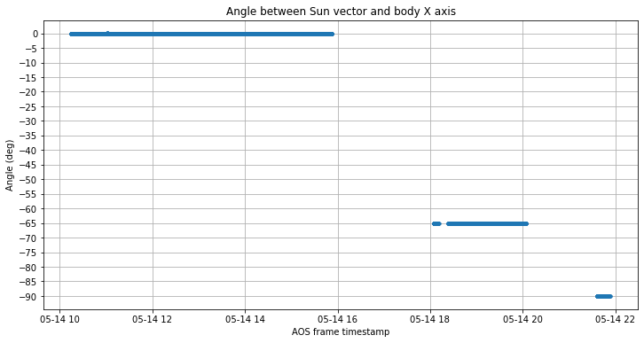
Before the first gap, the spacecraft maintains the 0 degree angle it had had since arriving to Mars orbit. The first gap corresponds to the deorbit burn. After this, the spacecraft has a -65 degree angle. The second gap corresponds to the collision avoidance burn. The spacecraft then resumes with a -90 degree angle and continues in that attitude.
The full plot corresponding to all the time that Tianwen-1 has been in Mars orbit, since its arrival in February and until the present day, is shown next. We see that since the day of the landing, the attitude has changed so that the Sun vector has an angle of -90 degrees with respect to the X axis.
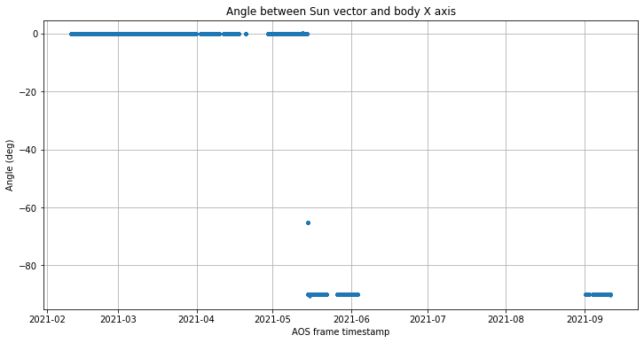
The figure that defines the body axes is shown below for convenience. A Sun angle of 0 degrees means that the Sun is directly in front of the lander capsule. A Sun angle of -90 degrees means that the Sun vector is the -Z vector, so the Sun is roughly in front of the high-gain antenna.
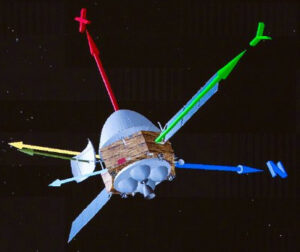
This change in attitude might make sense because of two reasons. First, the release of the lander perhaps changes the thermal properties of the spacecraft, so that it is no longer advantageous to have the sun on the +X face of the spacecraft.
Second, as Mars gets closer to solar conjunction (which will happen in October), the angle between the Earth and the Sun as seen from the spacecraft decreases. Therefore, at some point the Sun angle should be arranged so that the Sun is more or less in front of the high-gain antenna, so that the antenna has enough slew range to point towards Earth.
The figure below gives good intuition for this. The angle between the Earth vector and the -Z axis corresponds roughly to the angle that the high-gain antenna needs to slew to point towards Earth. We see that the angle was increasing until the day of the landing, where the attitude change happened. If it were not for this change, it would have grown up to almost 90 degrees.
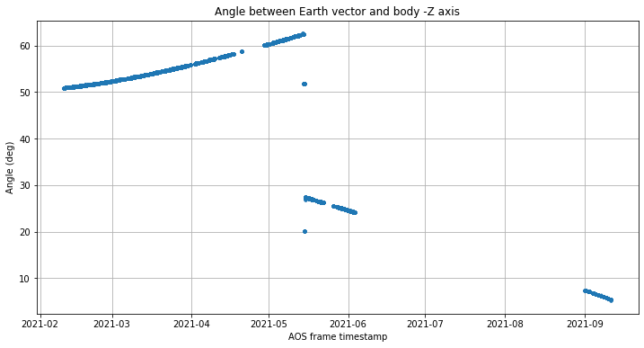
However, instead of simply subtracting 90 degrees to the Earth angle, we see that the attitude change has also mirrored the angle along the 0 degrees line. The reason for this is that not only the spacecraft has changed the Sun angle by 90 degrees. It has also changed the Y axis by 180 degrees, thus exchanging which solar panel points north and which points south (recall that the Y axis is nearly orthogonal to the ecliptic). This is evidenced by the following plot.
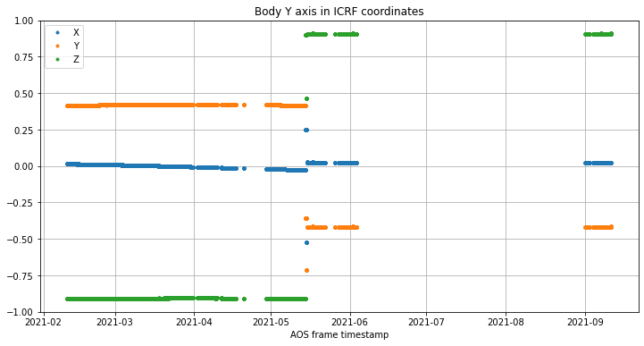
I don’t know the reason for this flip along the Y axis. Perhaps the antenna is not able to slew -30 degrees, which is nearly what it would have needed if the flip hadn’t been done.
Interestingly, after the attitude change the angle between the Earth vector and the XZ plane has become non-zero, but still small enough to say that the XZ plane almost coincides with the ecliptic.

The fact that the Sun angle has not changed in the four months that have passed since the landing suggests that the nominal attitude has nothing to do with communications with the rover (pointing the antennas towards the rover, etc.). Probably the attitude is changed for the communications sessions.
In fact, recall that the communications orbit has a period of 1/3 of a Mars sidereal day, so that the orbiter passes over the rover every 3 periapsides (and also on the apoapsides of the 2 other revolutions in each group of 3). All this geometry is aligned to the fixed stars, so from the point of view of these passes, the relative location of the Sun changes as Mars rotates around the Sun (put another way, the local solar time of the passes keeps changing). However, the attitude of the spacecraft tracks the Sun, so we notice that the attitude of the orbiter with respect to the rover keeps changing.
In a future post we will take a more detailed look at this communications orbit.
2 comments